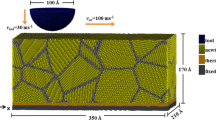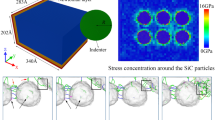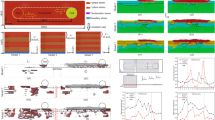Abstract
Context
Molecular dynamics (MD) was carried out to simulate the friction behavior of Ni-Cr alloy coating containing pores. The mechanical properties, displacement, abrasion depth, and defect change patterns of the coating under nano-friction were studied. It was found that the stacking fault would extend to the pores, and both tangential and normal forces decreased when the grinding ball was above the pores. Meanwhile, the pores changed the extension direction of shear strain inside the coating, and stress concentrations were generated at the pores. In addition, the deformation behavior inside the coating was influenced by the processing depth, the smaller the relative height of the grinding ball and the pore, the greater the atomic deformation around the pore. The pores changed the path of atomic movement, resulting in less deformation of the coating below the pores. The presence of pores promoted the generation of surface steps and increased the amount of wear on the coating. It was also found that pores facilitated energy release and provided space for dislocation extension, and the large accumulation of dislocations led to frictional strengthening near the pores, which enhanced the properties of the material below the pores. It was found that the increase of the pore size caused the normal force decrease and the wear performance of the coating decrease, but the thermal insulation performance would be improved.
Methods
In this paper, nanoscale modeling was performed in the large-scale atomic/molecular parallel simulator (LAMMPS) simulation environment. The model was visualized and analyzed in three dimensions by Open Visualization Tool (OVITO), the common neighbor analysis (CNA) method was used to obtain the atomic structure information, and the dislocation analysis (DXA) method was applied to obtain the dislocations.




















Similar content being viewed by others
Data availability
Data will be made available on request.
References
Wu R, Yin Q, Wang J, Mao Q, Zhang X, Wen Z (2021) Effect of Re on mechanical properties of single crystal Ni-based superalloys: insights from first-principle and molecular dynamics. J Alloys Compd 862:158643. https://doi.org/10.1016/j.jallcom.2021.158643
Ma Z, Pei Y-L, Luo L, Qin L, Li S-S, Gong S-K (2021) Partitioning behavior and lattice misfit of γ/γ′ phases in Ni-based superalloys with different Mo additions. Rare Met 40:920–927. https://doi.org/10.1007/s12598-019-01309-z
Chen B, Li Y, Şopu D, Eckert J, Wu W (2023) Molecular dynamics study of shock-induced deformation phenomena and spallation failure in Ni-based single crystal superalloys. Int J Plasticity 162:103539. https://doi.org/10.1016/j.ijplas.2023.103539
Kopec M, Kukla D, Yuan X, Rejmer W, Kowalewski ZL, Senderowski C (2021) Aluminide thermal barrier coating for high temperature performance of MAR 247 nickel based superalloy. Coatings 11:48. https://doi.org/10.3390/coatings11010048
Ludwig C, Rabold F, Kuna M, Schurig M, Schlums H (2020) Simulation of anisotropic crack growth behavior of nickel base alloys under thermomechanical fatigue. Eng Fract Mech 224:106800. https://doi.org/10.1016/j.engfracmech.2019.106800
Zhu Z, Wang H, Qiang Z, Jiao S, Wang L, Zheng M, Zhu S, Cheng J, Yang J (2021) Molecular dynamics study on nano-friction and wear mechanism of nickel-based polycrystalline superalloy coating. Coatings 11:896. https://doi.org/10.3390/coatings11080896
Sudagar J, Lian J, Sha W (2013) Electroless nickel, alloy, composite and nano coatings–a critical review. J Alloys Compd 571:183–204. https://doi.org/10.1016/j.jallcom.2013.03.107
Dai G, Wu S, Huang X (2022) Preparation process for high-entropy alloy coatings based on electroless plating and thermal diffusion. J Alloys Compd 902:163736. https://doi.org/10.1016/j.jallcom.2022.163736
Cha JH, Hong W, Noh S, Cho S (2018) Pore-size effects on thermal conductivity of SiO2 quartz using non-equilibrium molecular dynamics simulations. J Theor Comput Chem 17:1850010. https://doi.org/10.1142/s0219633618500104
Li J, Li J, Zhao Q, Chen Y, Chen J (2023) Effect of pore design on the mechanical properties of nanoporous high-entropy alloys. Int J Refract Met Hard Mater 111:106089. https://doi.org/10.1016/j.ijrmhm.2022.106089
Li L, He K, Sun S, Yang W, Yue Z, Wan H (2020) High-temperature friction and wear features of nickel-based single crystal superalloy. Tribol Lett 68:1–12. https://doi.org/10.1007/s11249-020-1266-4
Fleury R, Paynter R, Nowell D (2014) The influence of contacting Ni-based single-crystal superalloys on fretting fatigue of Ni-based polycrystalline superalloys at high temperature. Tribol Int 76:63–72. https://doi.org/10.1016/j.triboint.2014.01.011
Xu Z, Li D, Lu Z, Lv X, Liu Y, Peng J, Zhu M (2023) Study on the damage evolution of fretting wear in an Inconel 718 laser cladding alloy layer at different temperatures. Tribol Int 179:108092. https://doi.org/10.1016/j.triboint.2022.108092
Zhai H, Huang Z (2004) Instabilities of sliding friction governed by asperity interference mechanisms. Wear 257:414–422. https://doi.org/10.1016/j.wear.2004.01.018
Cui Y, Zheng M, Zhang W, Wang B, Zhang L (2019) Study of dry sliding friction and wear behavior of bionic surface of hardened steel. Mater Express 9:535–544. https://doi.org/10.1166/mex.2019.1543
Sun T, Wang Q, Sun D, Wu G, Na Y (2010) Study on dry sliding friction and wear properties of Ti2AlN/TiAl composite. Wear 268:693–699. https://doi.org/10.1016/j.wear.2009.11.007
Blau PJ, Devore CE (1990) Sliding friction and wear behaviour of several nickel aluminide alloys under dry and lubricated conditions. Tribol Int 23:226–234. https://doi.org/10.1016/0301-679x(90)90027-m
Xu Y, Wang M, Zhu F, Liu X, Chen Q, Hu J, Lu Z, Zeng P, Liu Y (2019) A molecular dynamic study of nano-grinding of a monocrystalline copper-silicon substrate. Appl Surf Sci 493:933–947. https://doi.org/10.1016/j.apsusc.2019.07.076
Ko W-S, Grabowski B, Neugebauer J (2015) Development and application of a Ni-Ti interatomic potential with high predictive accuracy of the martensitic phase transition. Phys Rev B 92:134107. https://doi.org/10.1103/PhysRevB.92.134107
Feng Q, Song X, Xie H, Wang H, Liu X, Yin F (2017) Deformation and plastic coordination in WC-Co composite—molecular dynamics simulation of nanoindentation. Mater Des 120:193–203. https://doi.org/10.1016/j.matdes.2017.02.010
Hosseini SV, Vahdati M (2012) Modeling the effect of tool edge radius on contact zone in nanomachining. Comput Mater Sci 65:29–36. https://doi.org/10.1016/j.commatsci.2012.06.037
Xu F, Fang F, Zhang X (2018) Effects of recovery and side flow on surface generation in nano-cutting of single crystal silicon. Comput Mater Sci 143:133–142. https://doi.org/10.1016/j.commatsci.2017.11.002
Lubarda V, Schneider M, Kalantar D, Remington B, Meyers M (2004) Void growth by dislocation emission. Acta Mater 52:1397–1408. https://doi.org/10.1016/j.actamat.2003.11.022
Cui Y, Chen Z (2015) Molecular dynamics modeling on the role of initial void geometry in a thin aluminum film under uniaxial tension. Model Simul Mater Sci Eng 23:085011. https://doi.org/10.1088/0965-0393/23/8/085011
Qi Y, Chen X, Feng M (2020) Molecular dynamics-based analysis of the effect of voids and HCP-phase inclusion on deformation of single-crystal CoCrFeMnNi high-entropy alloy. Mater Sci Eng A 791:139444. https://doi.org/10.1016/j.msea.2020.139444
Gao T, Song H, Wang B, Gao Y, Liu Y, Xie Q, Chen Q, Xiao Q, Liang Y (2023) Molecular dynamics simulations of tensile response for FeNiCrCoCu high-entropy alloy with voids. Int J Mech Sci 237:107800. https://doi.org/10.1016/j.ijmecsci.2022.107800
Zhao L, Liu Y (2020) Investigation on void growth and coalescence in single crystal copper under high-strain-rate tensile loading by atomistic simulation. Mech Mater 151:103615. https://doi.org/10.1016/j.mechmat.2020.103615
Dai H, Wu W, Fan W, Du H (2022) Investigation on mechanism of ultraprecision three-body polishing of single-crystal silicon carbide with voids by molecular dynamics simulation. Appl Phys A 128:815. https://doi.org/10.1007/s00339-022-05950-x
Li J, Fang Q, Liu B, Liu Y (2016) The effects of pore and second-phase particle on the mechanical properties of machining copper matrix from molecular dynamic simulation. Appl Surf Sci 384:419–431. https://doi.org/10.1016/j.apsusc.2016.05.051
Yang B, Zheng B, Hu X, Zhang K, Li Y, He P, Yue Z (2016) Atomistic simulation of nanoindentation on incipient plasticity and dislocation evolution in γ/γ′ phase with interface and void. Comput Mater Sci 114:172–177. https://doi.org/10.1016/j.commatsci.2015.12.021
Liang S, Huang M, Li Z (2015) Discrete dislocation modeling on interaction between type-I blunt crack and cylindrical void in single crystals. Int J Solids Struct 56:209–219. https://doi.org/10.1016/j.ijsolstr.2014.11.012
Liu T, Groh S (2014) Atomistic modeling of the crack–void interaction in α-Fe. Mater Sci Eng A 609:255–265. https://doi.org/10.1016/j.msea.2014.05.005
Wang L, Liu Q, Shen S (2015) Effects of void–crack interaction and void distribution on crack propagation in single crystal silicon. Eng Fract Mech 146:56–66. https://doi.org/10.1016/j.engfracmech.2015.07.021
Wang J, Liang J, Wen Z, Yue Z (2019) Atomic simulation of void location effect on the void growth in nickel-based single crystal. Comput Mater Sci 160:245–255. https://doi.org/10.1016/j.commatsci.2018.12.053
Zhang Y, Jiang S, Zhu X, Sun D (2016) Orientation dependence of void growth at triple junction of grain boundaries in nanoscale tricrystal nickel film subjected to uniaxial tensile loading. J Phys Chem Solid 98:220–232. https://doi.org/10.1016/j.jpcs.2016.07.018
Yang B, Zheng B, Hu X, He P, Yue Z (2015) Effect of void on nanoindentation process of Ni-based single crystal alloy. Acta Metall Sin 52:129–134. https://doi.org/10.11900/0412.1961.2015.00193
Zhang P, Zhang Q, Fang Y, Yue X, Yu X, Wang Y (2021) Research on the mechanism of surface damage of Ni-based high-temperature alloy GH4169 based on nano-cutting. Vacuum 192:110439. https://doi.org/10.1016/j.vacuum.2021.110439
Lunev A, Starikov S, Aliev T, Tseplyaev V (2018) Understanding thermally-activated glide of 1/2< 110>{110} screw dislocations in UO2–a molecular dynamics analysis. Int J Plasticity 110:294–305. https://doi.org/10.1016/j.ijplas.2018.07.003
Xia W, Zhao X, Yue L, Zhang Z (2020) A review of composition evolution in Ni-based single crystal superalloys. J Mater Sci Technol 44:76–95. https://doi.org/10.1016/j.jmst.2020.01.026
Verlet L (1967) Computer" experiments" on classical fluids. I. Thermodynamical properties of Lennard-Jones molecules. Phys Ther Rev 159:98. https://doi.org/10.1103/physrev.159.98
Deluigi OR, Pasianot RC, Valencia F, Caro A, Farkas D, Bringa EM (2021) Simulations of primary damage in a high entropy alloy: probing enhanced radiation resistance. Acta Mater 213:116951. https://doi.org/10.1016/j.actamat.2021.116951
Angelo JE, Moody NR, Baskes MI (1995) Trapping of hydrogen to lattice defects in nickel. Model Simul Mater Sci Eng 3:289. https://doi.org/10.1088/0965-0393/3/3/001
Foiles S, Baskes M, Daw MS (1986) Embedded-atom-method functions for the fcc metals Cu, Ag, Au, Ni, Pd, Pt, and their alloys. Phys Rev B 33:7983. https://doi.org/10.1103/physrevb.33.7983
Hao Z, Cui R, Fan Y, Lin J (2019) Diffusion mechanism of tools and simulation in nanoscale cutting the Ni–Fe–Cr series of Nickel-based superalloy. Int J Mech Sci 150:625–636. https://doi.org/10.1016/j.ijmecsci.2018.10.058
Zhu Z, Jiao S, Wang H, Wang L, Zheng M, Zhu S, Cheng J, Yang J (2022) Study on nanoscale friction and wear mechanism of nickel-based single crystal superalloy by molecular dynamics simulations. Tribol Int 165:107322. https://doi.org/10.1016/j.triboint.2021.107322
Archard J (1953) Contact and rubbing of flat surfaces. J Appl Phys 24:981–988. https://doi.org/10.1063/1.1721448
Funding
The work was supported by the National Natural Science Foundation of China (Grant No.52265025), the National Natural Science Foundation of China (Grant No.51975558), and the Open Project of State Key Laboratory of Solid Lubrication (LSL-2215).
Author information
Authors and Affiliations
Contributions
Writing-Original Draft and Formal analysis, (Weihua Chen); Data Curation, Visualization and Editing, (Yanjie Liu); Investigation and Conceptualization (Dingfeng Qu); Validation and Supervision (Min Zheng); Investigation and Formal analysis (Qifa Lang); Methodology, Resources and Supervision, (Shengyu Zhu); Methodology, Resources and Validation, (Zongxiao Zhu).
Corresponding author
Ethics declarations
Ethical approval
We declare that our paper has not been submitted or published elsewhere. All data in this paper are true and reliable, and the main data and charts have not been published. This article does not contain plagiarism or infringement of others’ intellectual property rights. This study does not involve human or animals.
Conflict of interest
We declare that we have no financial and personal relationships with other people or organizations that can inappropriately influence our work, there is no professional or other personal interest of any nature or kind in any product, service and/or company that could be construed as influencing the position presented in, or the review of, the manuscript entitled, “Effect of Pores on Microscopic Wear Properties and Deformation Behavior of Ni-Cr Alloy Coating”.
Additional information
Publisher’s note
Springer Nature remains neutral with regard to jurisdictional claims in published maps and institutional affiliations.
Rights and permissions
Springer Nature or its licensor (e.g. a society or other partner) holds exclusive rights to this article under a publishing agreement with the author(s) or other rightsholder(s); author self-archiving of the accepted manuscript version of this article is solely governed by the terms of such publishing agreement and applicable law.
About this article
Cite this article
Chen, W., Liu, Y., Qu, D. et al. Effect of pores on microscopic wear properties and deformation behavior of Ni-Cr alloy coating. J Mol Model 29, 330 (2023). https://doi.org/10.1007/s00894-023-05734-x
Received:
Accepted:
Published:
DOI: https://doi.org/10.1007/s00894-023-05734-x




